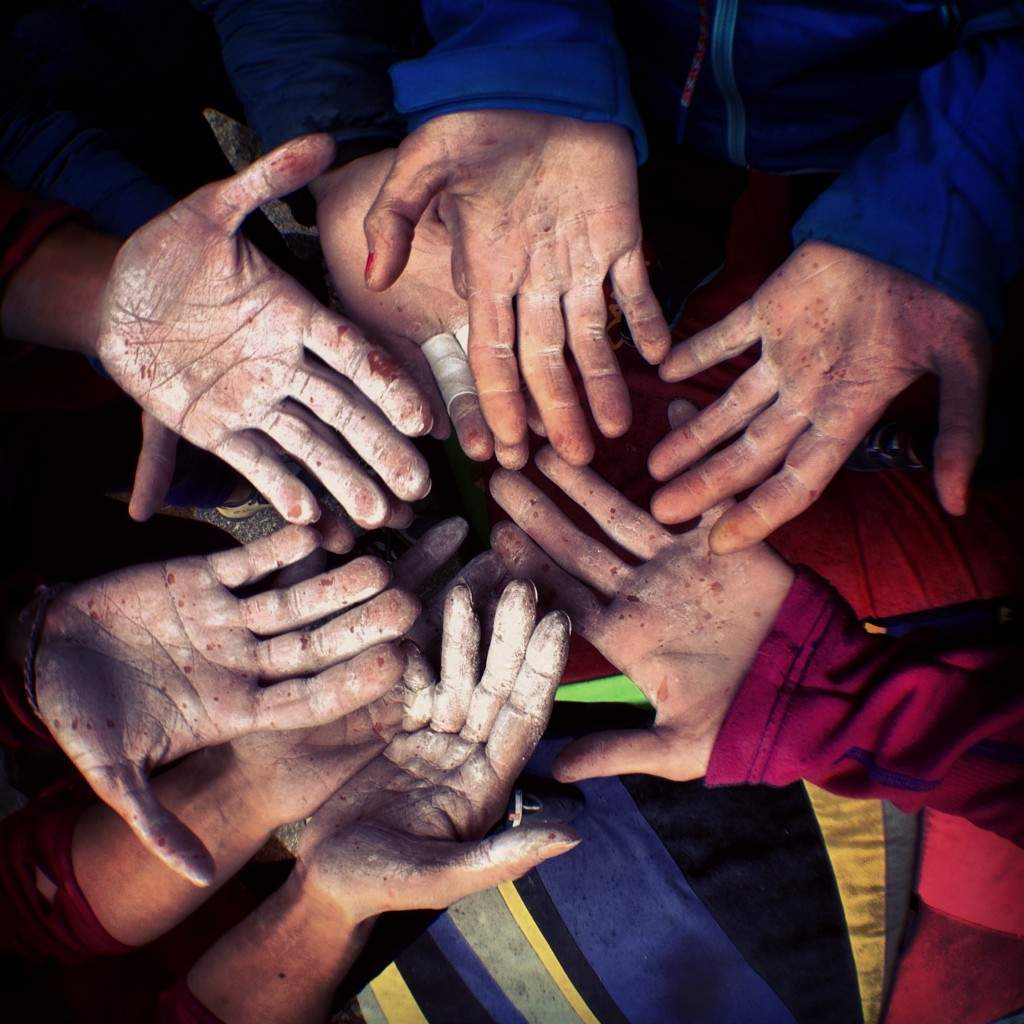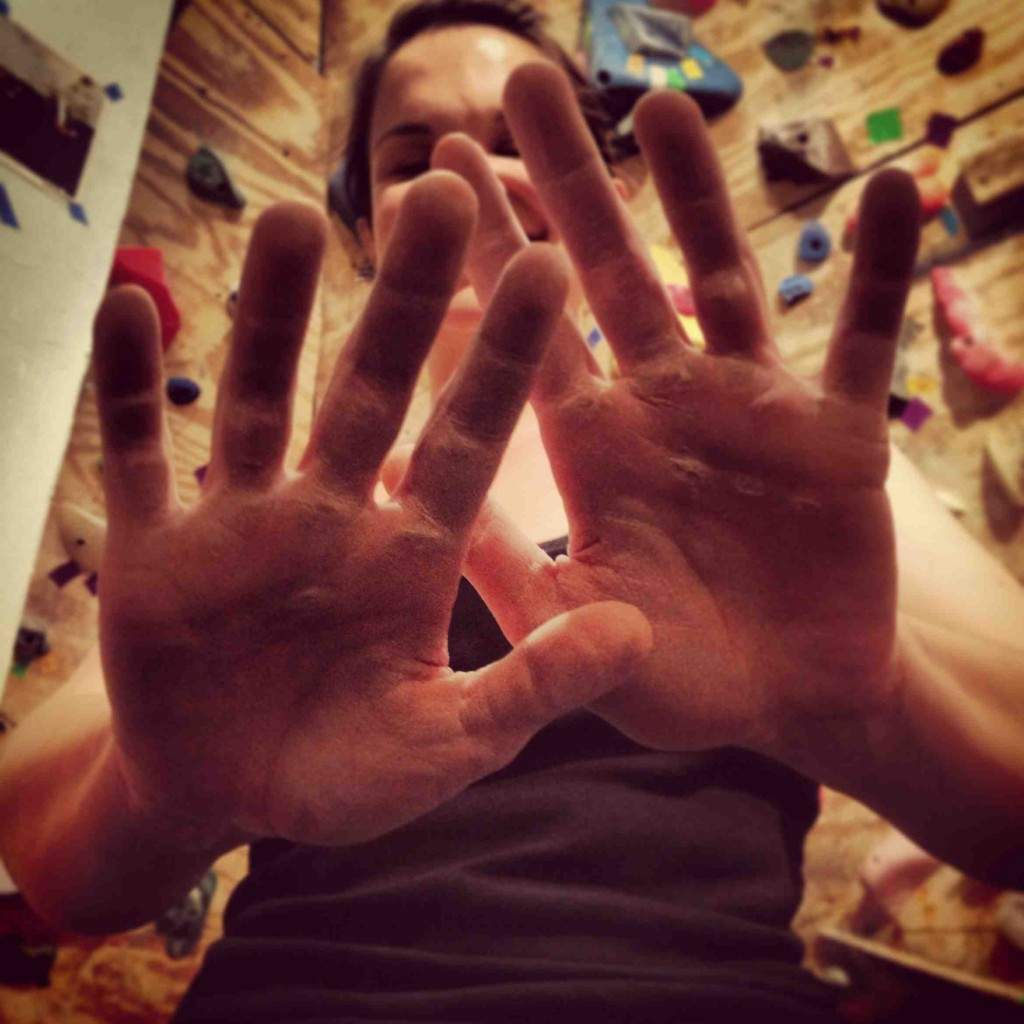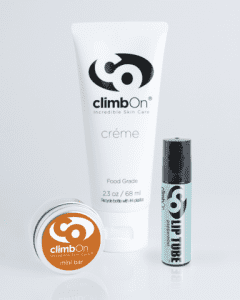Let’s find out how to deal with your gnarly hands. Don’t even get a climber started on hand care. We climbers are a pretty obsessive bunch when it comes to certain details – shoes, shoe sizing, skin care, humidity, rock types, ropes, gear, grades, beta, etc. We each have opinions on all of it, and some of us love to share these opinions, loudly. In the past, we did a post on foot care, and skin care, but so far have managed to tip-toe around this particular topic because we were dreading the angry comments it might inspire.

Look at these mitts! Our climber’s hands take some serious beating.
Check out another great interview with Whitney Boland, here!
In the end we came up with this: If you ask 100 climbers what the best way to care for hands is, you’ll get 100 different responses. In essence, there is not one “right” way. Everyone’s skin is different and has to do what works for them. So today we’ll share with you some wisdom from skin care specialists and professional climbers alike, and then you can choose to obsess about it however you wish (because that’s just what we climbers do best). Here are some common questions climbers ask about skin care:
Should I Moisturize My Gnarly Hands?
This issue is probably where two camps diverge the most in terms of skin care philosophy. I know some climbers who avoid moisturizer like it’s the ebola virus. The main concern that this camp has is that moisturizing will soften and break down the hard-earned calluses. Some people also may just avoid moisturizing the morning before a day out climbing, so as not to potentially reduce the amount of friction they can get with their hands. In some ways this makes sense, so we asked around for some other opinions.
We asked pro climber Angie Payne, and she said that she has tried in the past to avoid moisture, and realized that for her, “Dry hands aren’t always the happiest hands. I find that allowing my hands to stay moisturized actually helps with healing more than avoiding moisture does.” Meagan Martin echoed a similar sentiment, “I moisturize on a daily basis, and some people think that you shouldn’t moisturize, but I find that if I don’t my skin hurts more.” Both said that after a day of climbing if their hands are rough, especially after outdoor climbing, they put a salve on before bed to treat cracked skin and split tips.
If you look around at climbers and what they have in their packs or in their gyms, you will rarely see a cream moisturizer, but instead some type of salve or balm. So, why is that? Well, we got some answers from Tyler Ward, President of Giddy Organics,”As climbers, we work really hard for our callouses, so it’s better to heal the top layer of your skin, the keratin which is the part that cracks, gets split tips, and rips, tears, and blisters.
We wanted to do this while keeping your tough spots tough…we purposely utilize highly comedogenic (pore clogging) oils so the light healing aspects to the hand balm cannot penetrate deep into your skin and dissolve callouses.” So in essence using a balm or salve gives us the best of both worlds, moisture for that dry cracked outer layer, and preservation of those nice rough spots you put in the hours for. Some other tips we heard to maintain your skin in good condition are:
- Avoid chlorinated water like Meagan does
- Avoid super hot showers or taking baths
- Be like Angie and wear some “awesome purple dish gloves” to do the dishes when you want to preserve your “really good outdoor skin” 🙂

What Should I Do About Flappers?
While I haven’t researched it, it’s probably a fact that if you climb for enough months or years, you will get a flapper at some point. And when we say flapper, we aren’t talking about a stylish gal from the 1920’s. A flapper, for those of you who have not had the pleasure to get one (or see someone else get one) is when a callused patch of skin separates from the tissue below it, while you are climbing, and rips off all at once in a big flap. Delightful, huh? If you have an Instagram feed, and you follow some climbers, you’ll get a great education in flappers (one of the many things we climbers love about Instagram).
Are there any ways to avoid or minimize these? “Yeah,” Tyler says, “the main way people get flappers is washing their hands in the bathroom between climbs and wetting their hands in the sink. You can’t really avoid this without being gross, but you can avoid some of it by waiting a good 20 minutes and then re-chalking after getting your hands wet.” Meagan adds, “I feel like most flappers happen when you have really large calluses and you keep grabbing holds violently right on the calluses. Dynos should be avoided if your calluses are getting really big, which is why filing them down is a good idea for avoiding flappers.”
Can tape help? Tyler says, “Get really friendly with tape. If you are a climber who climbs twice a week, climb a few problems tape-free to strengthen your skin, then apply tape. You can normally see flappers coming 2-3 jugs before your skin ‘flaps’. So, when you feel it coming, drop off the rock, apply tape, and keep going.”
Should I File My Skin?
This is another polarizing issue when it comes to hand care. First off, filing is exactly as it sounds. Some people use emery boards, or sandpaper blocks (or pieces of sandpaper rolled into a tube “to get in the creases” says Angie), and this is a method of removing dead skin. Some people file down big calluses, some people wouldn’t dream of it. On the one end, “Some people call callouses ‘strengthened skin’ so it would be like filing down protruding muscles,” says Tyler. And on the other end we have Angie who says, “If my skin gets worn down/torn/split from outdoor climbing,
I sand down the calluses/cuts/splits…Although it sometimes seems counter-intuitive to sand down skin that is already compromised, I find that it often accelerates the healing”. So this is again another area of trial and error. Everyone’s skin is different and behaves in unique ways, so what works for one person won’t work for another.
If after reading this you are thinking of making some changes to your routine, here’s a few great products to try:

Giddy Organics Balm
This is an all natural, hand made balm and healing salve. It does double duty, both to moisturize that top layer of skin, while preserving calluses, and also goes in to heal cuts and scratches using natural ingredients. The great thing about this balm is that it sinks in very quickly, and doesn’t leave any greasiness at all. This balm is ideal for the person who may be new to using lotions or balms, and is sensitive to anything that feels greasy on the hands, but is still looking for a product to cure their sore, dry hands.
It comes in the traditional Cedar Mint scent (which I love) and also two new scents, Cooling Mint (which is apparently selling like hotcakes) and Lavender (which I have to try next). Enter our Instagram contest today (through the weekend) for a chance to win two full-size Giddy balms!

climbOn Lotion Bar and climbOn Creme
One of the many cool things about climbOn products is that they use only the highest quality food-grade ingredients, so if you wanted to, you could eat their product (and if you’re like Cate, who is obsessed with the smell of their products, you might). Another really cool thing: this is a woman-owned company, which we always love to support. The climbOn lotion bar was the first “hard lotion” I ever used. As I mentioned, it smells fantastic, and it really calms and soothes irritated, cracked skin, so it’s great to glide it on right after climbing.
The nice thing about bar-form lotions is that they are very portable, so you can keep it easily in your backpack, and it takes up no room.
The climbOn Creme is a newer product, and it is pretty miraculous. This is a more heavy-duty creme, and comes in a tube. I like to use this one at night before bed, and let it sink in. I like that it goes on very easily (as compared to the bars, which you have to kinda work around your knuckles and fingers), and also that it can really be used on any body part (so can all these other products, but the creme form makes it much easier to apply anywhere). It’s excellent for super chapped lips, or if you have any rough red patches.
This product is also safe and gentle enough to use on babies, or even dogs! Also, one last tip, climbOn makes a Lip Tube that I’m in love with. This winter it kept my lips smooth on the week I went from dry, hot, sunny desert weather in JTree, back to the horrible, wet and freezing cold weather of New England all in the same week, and that’s no small feat!
Enter our Instagram contest today for a chance to win a full-size climbOn lotion bar AND a full-size creme!
Other products we’ve heard great things about are Mac’s Smack Small Batch Balms (which Angie swears by to cure broken skin) and JTree Climbing Salve (which is Meagan’s go to, she puts it on at night, and says it really helps with split tips).
So, you have your pick of great products that are designed to help you care for your skin, while also maintaining the calluses that you need to climb your hardest. Or maybe you decide you don’t want to use a product, and that is up to you. After learning all of this information, the best thing we can recommend is do what works for you!
Climb On!
-Missy






